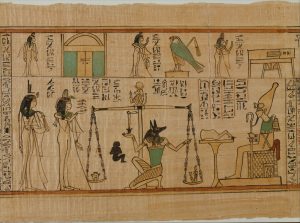Before there was paper, there was papyrus, opens a new window. The ancient Egyptians used the papyrus plant to create this early material. They layered thin strips of the plant and then applied pressure, which caused the layers to fuse together. Though the remaining papyrus that we see today is brown or yellow, originally it was white.
Egyptians wrote using hieroglyphics, opens a new window, or pictures as characters. This week at the Mandeville Branch Activity Table you can translate your name into Egyptian hieroglyphics, opens a new window! We can understand hieroglyphics thanks in part to the Rosetta Stone, opens a new window, a granite stone inscribed with a decree issued by King Ptolemy V in 196 BCE. The text is repeated in three different languages: Demotic (Egyptian script), ancient Greek, and hieroglyphics.
Papyrus wasn't just used by the Egyptians. It spread to ancient Greece and Rome as well. Some of the most well known papyrus scrolls are the Dead Sea Scrolls, opens a new window, which were discovered in Israel in 1947 and include parts of the Hebrew Bible among other texts.
To learn more about the history of the written word, visit us at the Mandeville Branch all November long to view the "Reading the World: Tablet to Tablet" exhibit! Or check out some of the library's books on the era when papyrus was used, including ancient Egypt, the Dead Sea Scrolls, and the Library of Alexandria.





Add a comment to: Tablet to Tablet: Papyrus